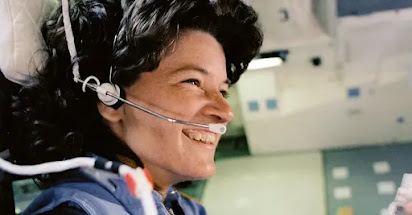On June 18th, 1983, Sally Ride became the first American woman in space. At this moment, the scientific community took a momentous leap towards bridging the gender gap, and barriers were broken for generations of young women to come. This is a mission that Sally would carry-on long past her time as an active astronaut. After Sally's passing in 2012, her obituary shared that she was openly gay, making her the first acknowledged gay astronaut in history. Even with two notable "firsts" to her name, Sally Ride was known to remain humble, kind, and generous. When talking about famous scientists, we tend to focus on awards and accolades. Though those things are important, it is also important to learn about who these people truly were in life. For that reason, some comments made by Sally's family and friends are included below.
"Sally lived her life to the fullest with boundless energy, curiosity, intelligence, passion, joy, and love. Her integrity was absolute; her spirit was immeasurable; her approach to life was fearless. Sally died the same way she lived: without fear. Sally's signature statement was 'Reach for the Stars.' Surely she did this, and she blazed a trail for all the rest of us". - Bear Ride, Sally Ride's sister, writing to NBC in tribute to Sally
"I was very fortunate to spend time with her right before she passed away. We were able to talk about what she envisioned for our company, and our legacy and her legacy...her true passion really was science education, and inspiring more young people, particularly girls, to follow a career path in science and technology..."- Karen Flammer, research physicist, business partner, and friend of Sally
Background:
- Sally Ride was born in 1951 in Los Angeles, California. She would remain in California and go on to attend Stanford University, receiving four degrees: Physics B.S., English B.A., Master of Science, & PhD in Physics.
- In 1978, she was 1 of 35 astronauts selected by NASA out of a pool of 8,000 astronauts.
- After 5 years of training, Sally was assigned to her first mission: STS-7. The goal of the mission was to deploy communication satellites and perform other experiments, and was 6 days long in total.
- Sally was selected again for a second mission (STS-41G) in 1984. The goal of this 8 day mission was to deploy the Earth Radiation Budget Satellite, demonstrate potential satellite refueling techniques, and conduct observations of Earth.
- Held a role on the Rogers Commission, the committee who investigated the Challenger accident.
- Held a position as special assistant to the NASA administrator for long-range and strategic planning.
- Took part in NASA's Gravity Recovery and Interior Laboratory Mission (GRAIL).
- Worked as a Professor of Physics at University of San Diego, California and was the director of the University of California's California Space Institute.
- Founded Sally Ride Science, with the intent to motivate girls and young women to pursue STEM careers.
NASA. “Sally Ride (1951-2012) - NASA Science.” Science.nasa.gov, science.nasa.gov/people/sally-ride/.
Boyle, Alan. “Why Sally Ride Waited until Her Death to Tell the World She Was Gay.” NBC News, 24 July 2012, www.nbcnews.com/sciencemain/why-sally-ride-waited-until-her-death-tell-world-she-908942.


I remember doing a report on Sally Ride in high school for one of my classes! I loved how she broke down barriers from many individuals and also helped support and stand up for the unrepresented. It’s sad and disappointing how many women like Sally Ride aren’t talk about enough. Great job!
ReplyDelete